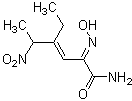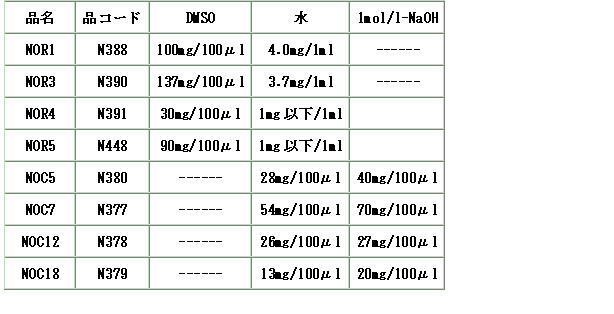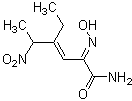上海金畔生物科技有限公司代理日本同仁化学试剂盒全线产品,欢迎访问日本同仁化学dojindo官网了解更多信息。
 NOR 3
NOR 3
NOR 3

- 酸化ストレス関連試薬
NO検出関連試薬
-
製品コードN390 NOR 3
-
CAS番号138472-01-2
-
化学名(?)-(E)-4-Ethyl-2-[(E)-hydroxyimino]-5-nitro-3-hexenamide
-
分子式・分子量C8H13N3O4=215.21
| 容 量 | メーカー希望 小売価格 |
富士フイルム 和光純薬 |
|---|---|---|
| 10 mg | ¥12,800 | 345-06941 |
- ご購入方法
- お問い合わせ
マニュアル
-
プロトコル
 NO を系の中に加えたい
NO を系の中に加えたい 
技術情報
注意事項
・本製品を粉末の状態で取り出し使用する場合、性状の性質上、静電気等の要因で容器内に付着し、取り出しにくい場合があります。
・容器内に付着し、取り出せなかった粉末に関しては、使用する溶媒を容器に入れ、溶かし出して使用してください。
参考文献
1) Y. Kita, R. Ozaki, S. Sakai, T. Sugimoto, Y. Hirasawa, M. Ohtsuka, H. Senoh, K. Yoshida and K. Maeda, "Antianginal Effects of FK409, a New Spontaneous NO Releaser", Br. J. Pharmacol., 1994, 113, 1137.
2) Y. Kita, Y. Hirasawa, K. Yoshida and K. Maeda, "Antiplatelet Activities of FK409, a New Spontaneous NO Releaser", Br. J. Pharmacol., 1994, 113, 385.
3) M. Hino, M. Iwami, M. Okamoto, K. Yoshida, H. Haruta, M. Okuhara, J. Hosoda, M. Kohsaka, H. Aoki and H. Imanaka, "FK409, a Novel Vasodilator Isolated from the Acid-treated Fermentation Broth of Streptomyces Griseosporeus I. Taxonomy, Fermentation, Isolation, and Physico-chemical and Biological Characteristics", J. Antibiot., 1989 XLII(11), 1578.
4) S. Shibata, N. Satake, N. Sato, M. Matsuo, Y. Koibuchi and R. K. Hester, "Characteristics of the Vasorelaxing Action of (3E)-4-Ethyl-2-hydroxyimino-5-nitro-3-hexamide FK409, a New Vasodilator Isolated from Microbial Sources, in Isolated Rabbit Arteries", J. Cardiovasc. Pharmacol., 1991, 17(3), 508.
5) Y. Kita, Y. Hirasawa, K. Maeda, M. Nishio and K. Yoshida, "Spontaneous Nitric Oxide Release Accounts for the Potent Pharmacological Actions of FK409", Eur. J. Pharmacol., 1994, 257, 123.
6) J.-L. Decout, B. Roy, M. Fontecave, J.-C. Muller, P. H. Williams and D. Loyaux, "Decomposition of FK409, a New Vasodilator: Identification of Nitric Oxide as Metaborite", Bioorg. Med. Chem. Lett., 1995, 5(9), 973.
7) S. Fukuyama, Y. Kita, Y. Hirasawa, T. Azuma, A. Sato, N. Morokoshi, S. Koda, T. Yasuda, S. Oka and H. Sakurai, "A New Nitric Oxide (NO) Releaser: Spontaneous NO Release from FK409", Free Rad. Res., 1995, 23(5), 443.
8) Y. Kita, K. Ohkubo, Y. Hirasawa, Y. Katayama, M. Ohno, S. Nishino, M. Kato and K. Yoshida, "FR144420, a Novel, Slow, Nitric Oxide-releasing Agent", Eur. J. Pharmacol., 1995, 275, 125.
9) M. Kato, S. Nishino, M. Ohno, S. Fukuyama, Y. Kita, Y. Hirasawa, I. Nakanishi, H. Takasugi and K. Sakane, "New Reagents for Controlled Release of Nitric Oxide. Structure-stability Relationships", Bioorg. Med. Chem. Lett., 1996, 6(1), 33.
10) Y. Kita, Y. Hirasawa, S. Fukuyama and K. Yoshida, "FK409, a Novel Spontaneous NO Releaser: Comparative Pharmacological Studies with ISDN", Cardiovasc. Rrug. Revi., 1996, 14(2), 148.
11) Y. Hirasawa, T. Sugimoto, S. Fukuyama, Y. Kato, H. Takamatu, M. Ohno, S. Nishino, M. Kato, K. Maeda, J. Seki and Y. Kita, "Antianginal Effects of FR144420, a Novel Nitric Oxide-releasing Agent", Eur. J. Pharmacol., 1996, 303, 55.
12) M. Sato and M. Kawatani, "Nitric Oxide Raises Cytosolic Concentrations of Ca2+ in Cultured Nodose Ganglion Neurons from Rabbits", Neurosci. Lett., 1996, 206, 69.
13) Y. Kita, Y. Hirasawa, S. Fukuyama, K. Ohkubo, Y. Kato, H. Takamatsu, M. Ohno, S. Nishino, M. Kato and J. Seki, "Oral Biological Activities of Spontaneous Nitric Oxide Releaser are Accounted for by their Nitric Oxide-releaseing Rates and Oral Absorption Manners", J. Pharmacol. Exp. Ther., 1996, 276(2), 421.
14) S. Fukuyama, Y. Hirasawa, Y. Kato, M. Nishino, M. Ohno, S. Nishino, K. Maeda, M. Kato and Y. Kita, "Structure-activity Relationships of Spontaneous Nitric Oxide Releasers, FK409 and its Derivatives", J. Pharmacol. Exp. Ther., 1997, 282(1), 236.
15) Y. Kita, Y. Hirasawa, Y. Kato, K. Ohkubo, M. Ohno, S. Nishino, M. Kato and S. Fukuyama, "Comparison of Hemodynamic Effects of Nitric Oxide (NO) Donors with Different NO-releasing Properties in Rats", J. Cardiovasc. Pharmacol., 1997, 30(2), 223.
16) Y. Hirasawa, Y. Kato, S. Fukuyama, M. Ohno, S. Nishino, M. Kato and Y. Kita, "Comparison of Antiplatelet Effect of two Nitric Oxide-donating Agents, FR146801 and FK409", Thrombosis Haemost., 1998, 79, 620.
よくある質問
-
Q
NOCとNORは両方ともNO発生剤として使用されますが、どう違うのですか?
-
A
構造的には全く異なるタイプのNOドナーです。
性能の違いとしては【NOC】
高水溶性
水溶液での調製が容易(NaOH溶液)
NOCは高pH(アルカリ性)ほどNO放出が遅くなる。半減期は(37℃、pH7.4)
NOC7(5min) > NOC5(25min) > NOC12(100min) > NOC18(21hrs)【NOR】
比較的水溶性が低い
有機溶媒(DMSO)溶液の方が安定に扱える。
経口投与が可能である。
NORは低pH(酸性)ほどNO放出が遅くなる。半減期は(37℃、pH7.4)
NOR1(1.8min) > NOR3(30min) > NOR4(60min) > NOR5(20hrs)
-
Q
NOR類を使用する際の溶解する溶媒は何がいいでしょうか?
-
A
乾燥DMSOをお使いください。
乾燥DMSOに溶解してストック溶液とし、所定量を試料溶液に加えます。
ストック溶液とした場合、一両日中にご使用下さい。
NO発生は事実上中性バッファー(サンプル溶液)に添加された時点から開始されます。
生理食塩水などの緩衝作用のないものでは、NOはきれいに放出しませんのでご注意ください。
-
Q
NOR3の溶解性を教えてください。
-
A
NORs、NOCsの溶解性は以下の通りです。

*注意*
NORsは水にも溶けますが、ストック液の調整は「DMSO」で行ってください。
中性の水では溶解直後から分解(NOの放出)が始まります。


取扱条件
| 性状: | 本品は白色結晶性粉末で、ジメチルスルホキシドに溶ける。 |
|---|---|
| 純度(HPLC): | 98.0% 以上 |
| ジメチルスルホキシド溶状: | 試験適合 |
| 1.危険物第5類 ニトロ化合物 危険等級Ⅱ, 2.保存方法:冷凍 | |
| 危険・有害 シンボルマーク |
 |
|---|---|


